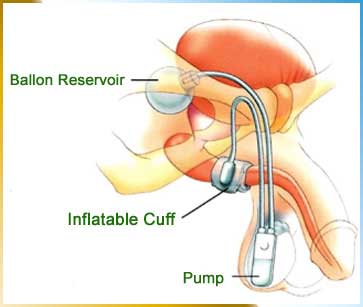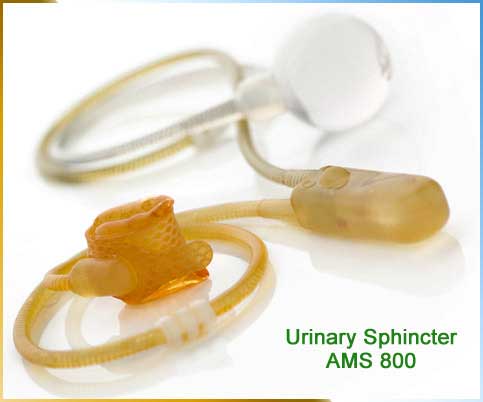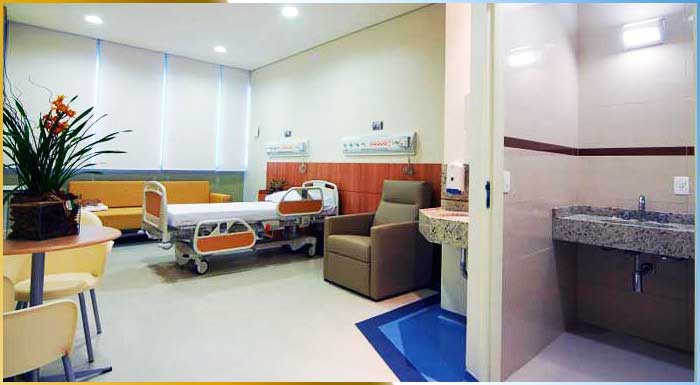Artificial Urinary Sphincter Surgery in India |
 |
What is Artificial Urinary Sphincter?
 In any normal person free from any ailment, the urinary tract consists of the kidneys, ureters, urinary bladder and the urethra. The Urine is produced by the kidneys, which is then passes through the tube-like organ called ureters and then is stored inside a muscular pouch known as the urinary bladder. A muscular sphincter known as the internal urethral sphincter is seen located over the neck of the bladder, which in turn prevents the urine from leaking outside the body. Also, one can find the pelvic muscles forming an external sphincter that further supports the function of the internal sphincter. In any normal person free from any ailment, the urinary tract consists of the kidneys, ureters, urinary bladder and the urethra. The Urine is produced by the kidneys, which is then passes through the tube-like organ called ureters and then is stored inside a muscular pouch known as the urinary bladder. A muscular sphincter known as the internal urethral sphincter is seen located over the neck of the bladder, which in turn prevents the urine from leaking outside the body. Also, one can find the pelvic muscles forming an external sphincter that further supports the function of the internal sphincter.
Once the bladder fills up, it is seen sendingout signals via the nerves and the spinal cord to the brain is seen giving the person a right feeling of fullness. When you find the person to be ready to pass the urine, the brain is seen sending out the signals to the bladder to contract and the urinary sphincters is seen relaxing the best. The urine then is seen passing via a small tubular structure that is known as the urethra and the patient is then able to make the bladder empty. In females, you can find the urethra to be short but in males, it is relatively long and comprises of three parts - the prostatic urethra that passes via the prostate, penile urethra that is located inside the penis, and the short membranous urethra that tend to connect the two. The penile urethra then comprises of the lower pendulous part, and the upper bulbous part.
Some people might suffer from the ailment called the urinary incontinence. These individuals simply cannot be seencontrolling the passing of urine. This results simply in urine leakage and it can cause to possible embarrassment. There are three key types of urinary incontinence:
-
Stress urinary incontinence: In in this ailment one can find the leakage of urine occurring at times when pressure in the abdomen is increased, for instance during the example, during coughing or sneezing.
-
Urge urinary incontinence: In this type of incontinence, one can find the leakage following only during the urgent urge to empty the bladder.
-
Overflow incontinence: This type of incontinence one can find dribbling of urine once the bladder is full.
Which Patients Benefit from an Artificial Urinary Sphincter?
An artificial urinary sphincter is found to be beneficial in a number of cases of severe stress urinary incontinence, which is not often controlled by simpler methods like the tablets and exercise of the perineal muscles. The stress urinary incontinence is often seen having only among the males following the surgical removal of the prostate for the treatment of prostate cancer. It can be even seen occurring rarely after once we find the endoscopic removal of prostate for benign conditions known as the Transurethral Resection of Prostate (TURP). Some of the other causes of the incontinence can include spinal cord injuries, which is seen interfering with the signals to and from the bladder, or inside the urethral injury due to pelvic fractures. The ailment of artificial urinary sphincter is often used in the females in a number of severe cases of stress incontinence, which is usually experience after the failure ofthe surgical procedure like the sub-urethral sling procedure.
What are the Types of Artificial Urinary Sphincters Available?
 There are several models of artificial urinary sphincters, which have been manufactured over the years considering the number of improvements that have been introduced in newer models. The most commonly used model, which is seen promoted and marketed a lot by the American Medical Systems and called AMS 800. This model has been tested extensively since the eighties and has stood up for the test of time with very low failure rates.If you talk about the AMS 800, it simply comprises of three key elements, an occlusive cuff, which goes around the urethra and it happens to be a balloon reservoir, which is placed in the area of abdomen and carry a control pump, which is simply seen getting placed over the scrotum in the males or over the labia in females. The components are then seen getting connected through two tubing connectors. There are several models of artificial urinary sphincters, which have been manufactured over the years considering the number of improvements that have been introduced in newer models. The most commonly used model, which is seen promoted and marketed a lot by the American Medical Systems and called AMS 800. This model has been tested extensively since the eighties and has stood up for the test of time with very low failure rates.If you talk about the AMS 800, it simply comprises of three key elements, an occlusive cuff, which goes around the urethra and it happens to be a balloon reservoir, which is placed in the area of abdomen and carry a control pump, which is simply seen getting placed over the scrotum in the males or over the labia in females. The components are then seen getting connected through two tubing connectors.
The cuff is then placed via an open surgical procedure found across the urethra. It has a fluid in it once you find the same inflated it ends up boosting the pressure over the urethra and thus is seen keeping things it closed. When the patient is keen to pass urine, he is seen pressuring the control pump, which is located at a convenient point found under the skin. This simply allows the fluid in the cuff to move into the balloon reservoir, thereby by releasing the pressure over the urethra and thus is seen allowing the urine to flow out. The cuff gets refilled on its own along with fluid from the balloon reservoir in just few minutes.Talking about the newer artificial sphincters one can find the same including the Flow-Secure, Periurethral Constrictor and ZSI 375 are also available.However, the costs of these artificial sphincters are seen getting very high especially as these may not be covered under any health insurance schemes. It is best to check in advance with the help of a competitive insurance provider before once get admitted to the hospital for such a surgery.
What Tests Should be conducted before the Procedure?
Once the patient reports with this ailment, the doctor carries out a complete history of the patient along with getting the physical examination that are necessary before even deciding upon the decision in order to use the artificial urinary sphincter device in the patient. The doctors carry out a couple of tests prior to the procedure including those that are routinely done before any surgical procedure is carried out and those which will further benefit the patients. Some of the tests carried out by the doctor can including the following:
-
Routine Tests: These include the test for hemoglobin levels, blood counts, function tests for liver and kidney and ECG for heart function to name a few. Also the urine is tested for any infection.
-
Ultrasound and Cystoscopy: These tests help in ruling out any structural problems found in the bladder. During the test of cystoscopy, a telescope-like instrument is put inside the urinary bladder, which further helps the doctor to inspect the inner layer for any abnormalities.
-
Urodynamic Testing: These tests help in evaluating the function of the bladder along with the urinary sphincter. There are several kinds of urodynamic tests that are available like the Uroflometry that measures the amount and speed of urine passed.
-
Pressure flow Study: This test helps in studying the pressure inside the bladder that is needed to generate urinary flow along with the flow rate of the urine
-
Voiding cystourethrography: This test deals with a radio-opaque dye, which is inserted into the bladder, and the doctor get the images are obtained as the patient passes urine
What is the Procedure for the Surgical Insertion of an Artificial Urinary Sphincter?
Before the doctor carries out the surgical procedure, the patient gets a detailed explanation of everything regarding the device including how the way to use the same. The patient is then expected to have a realistic expectation. Generally the hospital stay after the surgery is to 3 to 5 days. The patient is then given antibiotics and is generally prescribed before the procedure is carried out simply to prevent infection. The medications that helps in prevent clotting of blood has to be stopped once the doctors ask you the same. Before the surgery an overnight fasting is needed before the surgery. The surgical procedure is carried out with general anesthesia, which is injected and helps in keeping the patient feel the waist downwards. The surgeon is then seen inserting a Foley's catheter into the urethra. The approach for the surgery can be via the perineal area, scrotum or inside the lower abdominal region. Some of the surgeries are carried out via just one incision while others would need more than one incision.The size of the cuff is checked with the help of using a cuff sizer, which come along with the device. The cuff is placed either at the bladder neck or over the bulbous urethra. The pressure found in regulating the balloon is then inserted over the lower abdomen. A pouch is then created inside the scrotum and then the control pump is placed over the same.
What are the Post-operative Instructions that should be Given to the Patient?
After the surgical procedure, the patient is seen getting instructions to return after a week following the procedure once the sutures have been removed so that the device can be activated. The patient is then instructed on how to use that device called for the regular follow-ups. He should carry his ID Card indicating that he is using the device. This is really important because if the patient needs the same in the coming days it can be deactivated.
What are the Benefits and Risks of Artificial Urinary Sphincter?
The artificial urinary sphincter helps in improving upon the overall quality of life of patient with stress urinary incontinence. The patient is then saved from public embarrassment owing to the urinary leakage. But the real the protection may not be 100 percent and the patient may need the use of a pad as well. Some of the possible adverse effects of artificial urinary sphincter can include the following:
-
Erosion of the urethra under the cuff
-
Infection
-
Wearing off of the cuff
-
Mechanical failure or incorrect size of the cuff, which may require revision surgery

Artificial Urinary Sphincter Surgery Cost in India
India is regarded as the most affordable destination for a wide range of healthcare services. This certainly include the Urine leakage incontinence bladder surgery. If you talk about the Artificial Urinary Sphincter Surgery Cost in India, it comes to around 11000-12000 USD in comparison to the ones found in the US with the surgery amount as 17000-20000 USD. Hence one can find out good enough reasons to consider the same. But with low cost surgery the quality of the surgery is not hampered. All these factors give enough reasons to the global patient to consider the same.
Related Links:
TAG:
Artificial Urinary Sphincter Implant India, Cost Artificial Urinary Sphincter, Artificial Urinary Sphincter India, artificial sphincter, artificial urinary sphincter, bladder control problems, Irritable bladder, leaking urine, loss of bladder control, overflow incontinence, overflow urinary incontinence, stress incontinence, stress urinary incontinence, urge incontine, Artificial Urinary Sphincter Placement Overview |
 |
|
|
|





